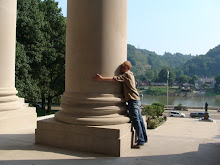Make Mine a Minaret
As many—if not all—of you will know, last week saw Swiss voters ban the construction of new minarets in their country.
 Fear, on one side, of watching Europe turn into "Eurabia"—even if the demographics don't justify such worries—and, on the other, of seeing centuries' worth of social liberalization—including women's suffrage and gay rights—fall apart in the face of religious conservatism, has led to the illegalization of an architectural form.
Fear, on one side, of watching Europe turn into "Eurabia"—even if the demographics don't justify such worries—and, on the other, of seeing centuries' worth of social liberalization—including women's suffrage and gay rights—fall apart in the face of religious conservatism, has led to the illegalization of an architectural form.
When your culture is under threat, ban a building.
Writing in the L.A. Times, Christopher Hawthorne calls it "Islamophobia lightly veiled"—whereas Ayaan Hirsi Ali, in a rambling article for the Christian Science Monitor, views it as "a rejection of political Islam, not a rejection of Muslims." The minaret, she continues, "is a symbol of Islamist supremacy"; its ban is thus a much-needed wall against what she calls "Muslim immigrant newcomers who feel that they are entitled, not only to practice their religion, but also to replace the local political order with that of their own." Writing on his own blog, meanwhile, architect Sam Jacob views this as a conflict over architectural ornament: "Switzerland has banned minarets," he writes. "In a sense, that is no real surprise coming from the home of architectural minimalism."
So what would happen if we temporarily—if only for the sake of argument—treated this whole thing as a design problem? What if architects could redesign minarets—what would that do to the efficacy of Switzerland's ban?
Archinect has stepped into the midst of this fight over religious expression, architectural form, visual traditions, national identity, future migration, international borders, the scenographic purity of the Alpine landscape, and more with a public design competition: Switzerland, We Have A Problem.
From the competition brief:
In the end, then, how might certain building types respond creatively to a legal ban? What private chapels might result if megachurches were universally denied planning permission—and what effect might this architectural gesture have on Christianity itself?
Might Switzerland, ironically, become a site of intense design virtuosity and formal mutation in the historical typology of the mosque?
_______________________________In my opinion the Minaret is critical to the mosque type. Why ban it? What does it harm or threaten? The freedom of an idea can't be stopped by banning an architectural form it only disguises it, which in tern makes the idea more complex to understand. It's stripped of it's physical form, and must become strictly ideological.The people of the Islamic faith won't be deterred just like the Christian faith wouldn't be deterred by the banning of a cross. I'm simply disappointed by the public votes cast, and will watch the situation closely.
When your culture is under threat, ban a building.
Writing in the L.A. Times, Christopher Hawthorne calls it "Islamophobia lightly veiled"—whereas Ayaan Hirsi Ali, in a rambling article for the Christian Science Monitor, views it as "a rejection of political Islam, not a rejection of Muslims." The minaret, she continues, "is a symbol of Islamist supremacy"; its ban is thus a much-needed wall against what she calls "Muslim immigrant newcomers who feel that they are entitled, not only to practice their religion, but also to replace the local political order with that of their own." Writing on his own blog, meanwhile, architect Sam Jacob views this as a conflict over architectural ornament: "Switzerland has banned minarets," he writes. "In a sense, that is no real surprise coming from the home of architectural minimalism."
So what would happen if we temporarily—if only for the sake of argument—treated this whole thing as a design problem? What if architects could redesign minarets—what would that do to the efficacy of Switzerland's ban?
Archinect has stepped into the midst of this fight over religious expression, architectural form, visual traditions, national identity, future migration, international borders, the scenographic purity of the Alpine landscape, and more with a public design competition: Switzerland, We Have A Problem.
From the competition brief:
- To address this impasse between the rightful expression of the Muslim religion and the value of Switzerland’s overwhelmingly scenic environment, we challenge you to design a solution that allows the best of both worlds. Can you design a minaret as event rather than object?
Your task is to design a deployable minaret that can attain full presence, visible from a distance, during each of the five daily calls to prayer.
You may use any technology you like, choose any site in Switzerland, and your minaret may reach any height so long as it’s at least twice as high as the building it sprouts from.
In the end, then, how might certain building types respond creatively to a legal ban? What private chapels might result if megachurches were universally denied planning permission—and what effect might this architectural gesture have on Christianity itself?
Might Switzerland, ironically, become a site of intense design virtuosity and formal mutation in the historical typology of the mosque?
_______________________________In my opinion the Minaret is critical to the mosque type. Why ban it? What does it harm or threaten? The freedom of an idea can't be stopped by banning an architectural form it only disguises it, which in tern makes the idea more complex to understand. It's stripped of it's physical form, and must become strictly ideological.The people of the Islamic faith won't be deterred just like the Christian faith wouldn't be deterred by the banning of a cross. I'm simply disappointed by the public votes cast, and will watch the situation closely.



No comments:
Post a Comment